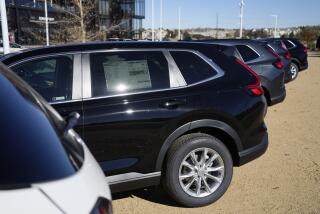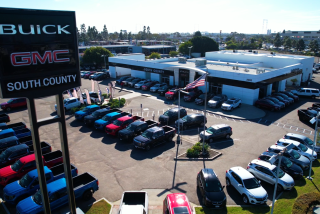Going Full Throttle : With the Help of Light Trucks, Last Year’s Strong Auto Sales Expected to Continue in ’97
- Share via
DETROIT — Riding the American obsession with gas-guzzling trucks, U.S. auto sales rose a strong 2% in 1996. And while sales slowed in December, the outlook is for a continuation of good times.
Auto makers sold an estimated 15.1 million cars and trucks, making last year one of the best ever, according to industry reports released Friday. Sales in California are expected to come in slightly better than the national rate.
The incessant demand for light trucks--pickups, minivans and sport-utility vehicles--is projected to continue to spur sales although at a slower pace in 1997. Competition will increase with a host of new models.
And foreign manufacturers, particularly the Japanese, should continue making market-share inroads with new cars and trucks that are priced lower because of the stronger dollar, incentives and cost cutting, analysts said.
“With the lower yen, they will be more aggressive on price,” said George Magliano, analyst with WEFA Group, a New York consulting firm.
The California market perfectly mirrored the nation’s where trucks are concerned, and Chrysler--the truck star for 1996--chose the Los Angeles Auto Show as the venue to announce its full-year sales gain of 13%. That meant a record 2.4 million vehicles and the highest share of the market since before its 1979 brush with bankruptcy.
Though there are signs of the truck boom leveling off, especially in California, Chrysler looks to extend its remarkable gains with a strong truck lineup and new, aggressively styled sedans. General Motors desperately hopes to staunch its market-share erosion with strong launches of a bevy of mid-size cars.
Ford is expected to keep the crowns for best-selling car and truck--Taurus and F-Series pickup. But with Honda’s Accord and Toyota’s Camry gaining momentum, it will be hard-pressed to keep Taurus at the top in 1997.
Auto sales, an important indicator of the nation’s economic strength, are expected to be in the 15-million vehicle range again this year. If achieved, it would mark the fifth consecutive year of strong sales, one of the longest periods of sustained steady sales in recent memory.
“No boom, no bust,” GM chief economist Mustafa Mohatarem said.
Analysts said auto sales should remain healthy as long as the economy continues its slow-growth pattern, interest rates remain low, unemployment and wage gains hold steady and consumer confidence remains buoyant.
There are some concerns: rising consumer debt levels, an average $20,000 new-car price, flattening used-car prices that could herald slower new-car sales, and, for Detroit, the strong dollar, which has risen 30% against the yen and mark since April 1995.
When all the sales reports are in on Monday, analysts expect that December sales will be down 2.5% from a year ago, one of 1995’s strongest months. Sales also were off in November, but analysts don’t see an imminent slowdown.
The main driver in last year’s sales gains was consumers’ unquenchable thirst for light trucks. Sales of fuel-hungry pickups, minivans and sport-utilities--seemingly the bigger the better--soared about 8.5% last year.
Meanwhile, passenger car sales dropped more than 7%.
Consumers are drawn to trucks because of their image, power and greater utility. The trend is prompting auto makers to develop so-called hybrid vehicles that combine the best attributes of cars and trucks, such as the Suburu Outback and the car-based Honda CR-V sport-utility.
For the year, truck sales captured more than 43% of the market, up from about 28% just a dozen years ago. Though the point is debatable, most experts don’t see the truck trend ending soon.
“To me, it’s entirely possible that before too long we will see a 50% [market share] on trucks,” Ford Chairman Alex Trotman said.
But there are some signs of softness in truck demand. In California, for instance, there has been a flattening in sales of sport-utilities, though sales are still good.
“There is beginning to be a slowdown, but it’s a bit early to predict a decline,” said John Rettie, who monitors California sales data for J.D. Power & Associates.
Large sport-utilities and full-size pickups have been the hottest segments. Compact sport-utilities are expected to come on strong. But minivans and compact pickups sales have been lackluster.
The truck-heavy market allowed Chrysler to capture a 16.2% market share, a gain of 1.5 percentage points--or about 225,000 vehicles--from the previous year. The gains could continue the next few years. “Eighteen or 20% share of the market is not unrealistic,” said Chrysler Chairman Robert Eaton in a recent meeting with reporters.
For GM, trucks were its only bright spot. Overall, sales for the No. 1 auto maker were down 2% in 1996. But truck sales were up 2% and surpassed 2 million vehicles for the first time.
GM’s car sales were hampered by slow new-model launches, labor strikes and consumer indifference. The company’s market share dropped to 31.4%, though executives promised it would recover to “more normal levels” with 15 new 1997 models.
Ford, which will not report sales until Monday, also has benefited from the strong truck market. It hopes for increased sales with the introduction of its full-size Ford Expedition and Lincoln Navigator sport-utilities to compete against GM’s popular Chevrolet Suburban.
It was a banner year for Honda, Toyota and the resurgent European manufacturers. The two Japan-based makers gained market share as they introduced new products that are less costly to make and restrained prices with help from the strong dollar. They did particularly well in the last quarter of the year. Nissan, Mitsubishi and Mazda lost ground.
The German auto makers--BMW, Mercedes-Benz, Volkswagen, Porsche and Audi--continued to increase sales with stylish sporty and luxury brands that were more reasonably priced than previous vehicles.
(BEGIN TEXT OF INFOBOX / INFOGRAPHIC)
Driving Growth
Market share for two of the nation’s top auto manufacturers slid last year. But sales soared for Chrysler Corp., thanks to its light trucks, and for Toyota and Honda, which benefited from the weaker yen. A comparison of 1995 and 1996 market shares for major players in the auto industry:
1995
General Motors: 32.7%
Ford: 26.0%
Chrysler: 14.6%
Toyota/Lexus: 7.2%
Honda/Acura: 5.3%
Nissan/Infiniti: 5.3%
Other: 8.4%
*
1996
General Motors: 31.4%
Ford: 25.3%
Chrysler: 16.2%
Toyota/Lexus: 7.7%
Honda/Acura: 5.6%
Nissan/Infiniti: 5.0%
Other: 8.8%
Source: Automobile News






